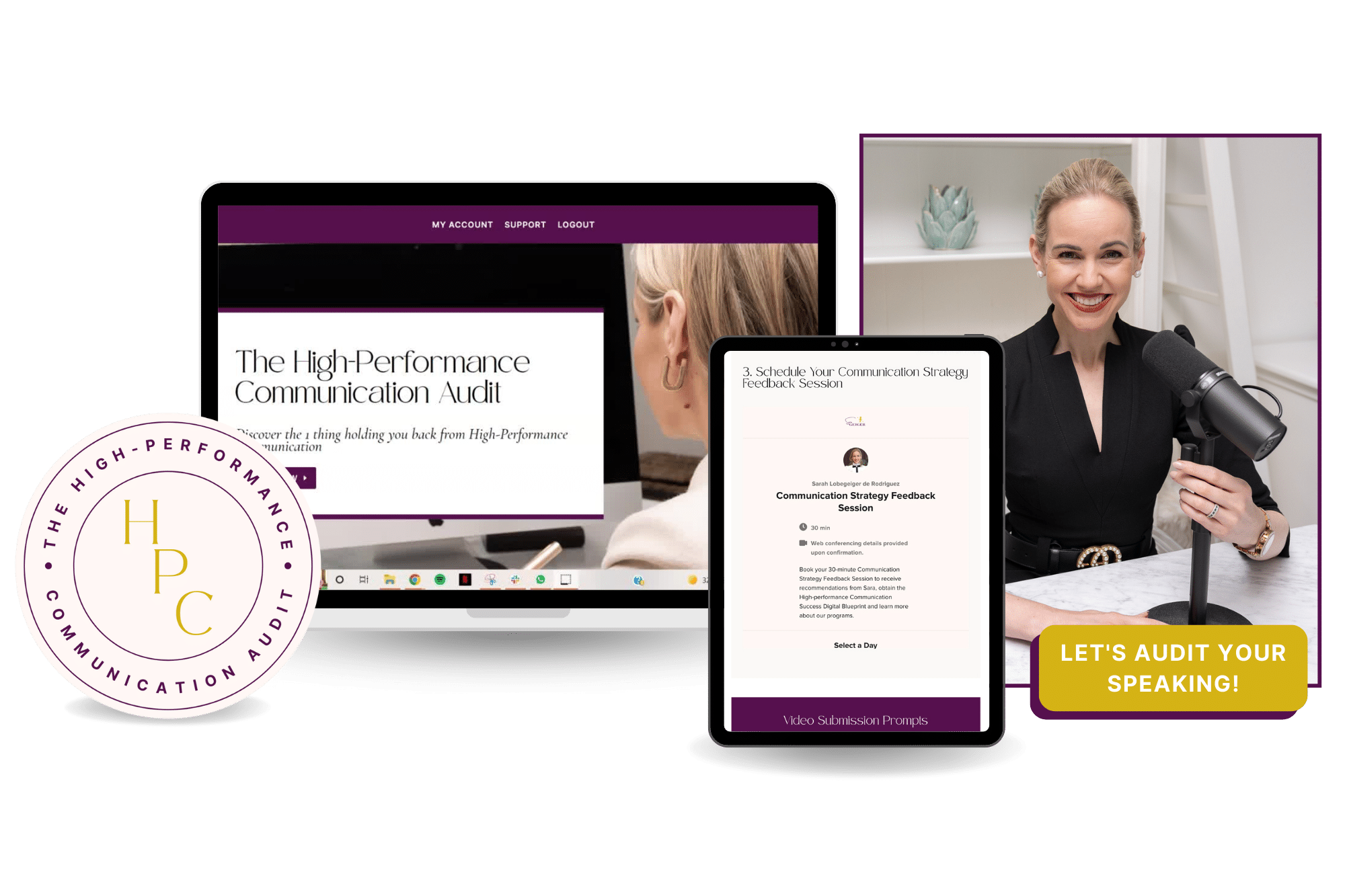Executive Presence
10 Tactics to Increase Your Executive Presence
Develop Your Executive Presence Fast

If you want to stand out at work, get people to take you more seriously, and increase your leadership potential – executive presence is a core skill to master.
When we feel sidelined at work, it can affect our confidence and career merit, and success. Things like imposter syndrome rapidly get in the way of our confidence at work and can sideline us. However, mastering executive presence skills can be the vital turnkey to feeling more self-assured at work. The best executive presence training allows you to command attention and show up with the leadership presence you need to advance your career.
In this blog you’ll learn 10 powerful tactics to develop your executive presence so that you can showcase your professional skills more effectively and get more influence at work.
Executive Presence is a requirement of Leadership Development
This blog is best digested in 10 manageable chunks. First, I’ve aimed to give you a comprehensive overview that will help you to consider your executive presence concerns.
You might want to bookmark this page to refer back to later – because it could take more than one sitting!
Here are the steps for you to get a stronger grasp on ingredients your communication needs so that you can showcase your Executive Presence.
- Read the 10 tactics below
- Watch Does Your Executive Presence Pass the Test?
- Pick up a copy of the Communication Growth Plan for Work and review areas that you can expand to extend your professional speaking skills.
- If you want to optimise your voice tone, boost your speaking & express yourself clearly, sign up for the Executive Communication Training with Cadenza.

Inspirational leaders show executive presence that inspires followers to share a vision that's authentic & meaningful.
I’ve met a lot of professionals completely frustrated with what they need to do to grow as a leader and finally get noticed and finally given management opportunities or win the desired promotion they’ve set their sights on.
In my work as communication performance consultant for emerging and executive leaders I work with you to implement actionable tactics that are backed by science that increase your impact, communication skills and ability to inspire.
Executive education programs often miss overt training in the communication skills needed to step capably into senior leadership positions.
This leaves many career-ambitious people scrambling for whatever feedback they can get from human resources or executive leadership about what they need to do to overcome imposter syndrome or increase their confidence. However, one of the biggest barriers I notice among my clients is the overwhelming unsolicited feedback from colleagues and managers around communication, usually without being asked!
It can be destabilising when someone tells you that you missed out on a promotion because of your communication or weak executive presence.
But developing executive presence is possible if you focus on gaining the skills you need to start resembling the communication style of senior leaders. If you want to build your executive presence you’ll need more than classes at business school might tell you.
And, structuring your leadership development to develop your executive presence is not something that many organisations offer or even understand, which is exactly why I’ve prepped this guide. If you apply research backed tactics to gain strong executive presence you can get it happening faster than most people who attain it with years of experience.
I hope that by the end of the article, you will have some fresh insights into how to hone your exective presence skills so that you can grow as a leader, build your personal brand and dial in on your career growth.
Maybe you’re an MBA student worrying about how to enter the management consulting space and clear the competition in interviews, or perhaps you’re an executive already who feels like they lack lustre, or a female leader curious about how to have presence as a woman in a male-dominated industry, either way, this article is going to give you some new perspectives for your leadership skills.
Now it’s time to uncover 10 New Tactics to add to your professional life so that you can get more merit for your leadership potential and skill.
Optimise your Voice Tone, Boost Your Delivery & Express Yourself Better.
I’ve provided speaking assessment and modern elocution training to people from all sorts of professions at different stages in their career path from middle management through to company directors.
Stop feeling second class in the office, because your ideas aren’t. You just need to learn to speak with authority, vocal charisma & clarity. My tools will show you how.
#1 Use collective language : We versus Me
A great example of this comes from Barack Obama’s 2008 election campaign. The words Obama used influenced and inspired the world.
His famous catchphrases: “Yes we can” and “Change we can believe in” stuck. Now imagine if Barack had said something along the lines of “Change I believe in” or “Yes, I can?”
Through his use of collective language Barack Obama powerfully positioned himself alongside us, thus increasing his persuasion and trustworthiness. Furthermore, this style of language positioning is a signal for active listening. Once you start incorporating the word “we” into your language, you’re more likely to start thinking more about your listener and giving them space in conversations.
This is a core feature of executive presence.
#2 Sharpen your appearance.
Your team and boss notice your nonverbal communication. Pay attention to how you balance your eye contact, your attire, and personal grooming. These factors influence listener bias and can increase your credibility and gravitas.
Where you can, dress formally, smart and sharp. Your contacts are more likely to rate you as intelligent and trustworthy if you look well presented. Don’t forget body language either, your posture, pace, gestural and facial cues need to be considered if you’re aiming for effective communication.

#3 Remove fillers & hesitations
Filler words and phrases like “um, err, the thing is, like and ah” tend to destabilise the logical connection and flow of our ideas. If you want to increase connection with your listeners you need to present a concise and logical message. Reduce repetitive words such as “so, just, a little bit and very”. Fillers destabilise your message but tighter sentences, increase your gravitas.
There are three pillars, regardless of your work culture, whether you’re in Silicon Valley or on Wall Street: how you look, how you speak, and how you behave. It’s all three things, and nailing them makes you a contender- SILVIA ANN HEWLETT
#4 Increase your speaking logic
Use concise sentences help your listeners to extract core details. Is there a way you can use less words to express your ideas? Aim for that! You’ll sound more convinced and less hesitant which translates as confident communication.
#5 Fine tune your voice tone
Vocal power and tone clarity are key components of executive presence. If we want to demonstrate leadership potential our voice needs to cut through the noise, catch attention and keep our team listening. Your voice has the power to convince and persuade if used effectively. I strongly recommend you work with an expert to polish your voice signal. I’ve linked a vlog on charismatic voice tone in the comments below so make sure you check it out if you want to learn more about this.
If you’re involved in public speaking activities, don’t neglect professional voice training – speaking in public without knowing how to use your voice is like driving a car without petrol. Voice tone is a key indicator of executive presence. Research has shown that higher engagement in a Ted talk often comes down to how well the speaker used their voice expression.
Get more tips for your public speaking comfort here.
Get more tips for your public speaking skills here.

#6 Study hard
People that come up with creative solutions when faced with deep challenging problems tend to have a higher executive presence. Inspirational leaders stand out as innovators and early adopters.
Executive presence usually comes across in individuals who show a different mindset, a creative take on things, and a new, fresh, innovative approach to solving some of the company’s deepest pain points. If you’re not exposing yourself to new cutting edge ideas in your industry, or even the world, you will struggle to keep up and demonstrate a point of difference from your competition. Look at where your expertise and skills align with current emerging trends in the world and global markets and fill the gaps with careful study and research.
You’ll feel more comfortable positioning your ideas and suggestions in team meetings and with your superiors if you’re across current affairs, industry updates, and best practices.
Another area to study is your own behaviour, reactions, and areas of discomfort. The key to poise and precision while interacting with others is managing your own emotions. If you struggle to regulate your emotional reactions and find them impacting on your work confidence and comfort, investing in emotional intelligence training with a communication consultant will be fruitful. I dedicate extensive work on social intelligence with my clients through my signature C-Suite program.
#7 Participate but don’t dominate
It’s easy to confuse showcasing your worth with dominating tasks at work. A lot of my clients have felt that if they speak up more, and push their ideas forward, more people will notice their potential.
However, this can really work against you if you’re aiming to improve your executive presence. Be strategic and tactical when you participate and find ways to speak up so that your message has more impact on the group. Carefully monitor your turn-taking skills, apply the rules of active listening and avoid interjecting and interrupting your conversation partners. Great leaders showcase their team. Executive presence is a tool that lets them inspire confidence in others. How can you do that more?
#8 Pitch actively for opportunities
Executive presence is all about positioning and influence. No matter what position you occupy in your company, you’ll only have influence if you find opportunities.
Pitch actively for opportunity. Don’t sit back, find ways to creatively innovate your role and your job description where possible.
Work within your KPIs, but apply a level of excellence so that you stand out and then pitch for more opportunities, pay, or promotions or you’ll get taken for granted.
#9 Build your public speaking portfolio
It’s very normal to feel anxious about public speaking. But I’m afraid if you leave that area unnoticed and unattended, you’re likely to fall behind. What sets people apart with high level executive presence is their ability to speak effectively and powerfully when faced with enormous pressure. Effective leaders can cut through the noise. They are able to speak confidently and concisely although overtired, stressed and faced with massive backlash or challenging difficulties or company pressures. Now is the time to build your public speaking portfolio, as it will prepare you for the elite level communication needed for leadership.

#10 Use a positive and proactive tone
Professional, engaging communication needs an active and motivating tone. So if you want to develop your executive presence, work on your expressive tone. You can do this by using positive action-based language that focuses on solutions, benefits, and innovative approaches to problems. If you’re in the habit of complaining about the challenges you face you run the risk of not demonstrating and portraying leadership potential. Leaders need to look to the future in order to inspire the team. So watch that your language isn’t getting bogged down with complaining.
We also know that listeners are more inclined to tune into your message if it has a positive motivating element. So find ways to change your perspective if you find yourself getting burdened with a lot of negativity, complaining, gossip, backlash, and failure to move and grow.
Executive presence can be learned, but to progress, you must deploy science-backed techniques.
Take some time to evaluate how you are tracking with these 10 tactics in your daily life because if you give them attention, you can actively boost your gravitas, credibility and persuasive skills. I wanted to capture a nice overview so that you can push your communication goals forward, get more impact at work, start to feel heard and valued, and ultimately increase your personal and professional success.
There’s a tight link between merit and communication. If you’re looking for an executive coach to work on your professional interaction skills make sure they are across the research on what works! I’ve prepared some tips on how to find the best coach for your communication that can help you narrow down the best option for your needs.
At Cadenza, we can help you to…
- Enhance your leadership communication skills, reputation management and presentation skills
- Develop your team’s communication abilities, emotional intelligence and ability to communicate more effectively under pressure.
Want to learn more?
The Ultimate Executive Presence Playlist
When we feel sidelined and like we’ve got no influence at work, it can really affect our confidence and career success. If you need some inspiration or an Executive Presence PEP TALK- check out this playlist.
Did you enjoy this post? Make sure to subscribe to our YouTube channel to get more content to increase your communication skills!
References
- Axelrod, R. (2017). Leadership and Self-Confidence. Chapter in book Leadership Today.
- Beeson, J. Deconstructing Executive Presence, Harvard Business Review, 2012
- Blazek, S. G. (2015). CEO Staying Power, Korn Ferry.
- Hewlett, S., Leader-Chivée, L., Sherbin, L, Gordon, J. and Dieudonné (2012). Executive presence. Coqual.
- Dagley, G. & Gaskin, C. (2014). Understanding executive presence: Perspectives on business professionals. Consulting Psychology Journal: Practice & Research, 66(3), 197-211. doi:10.1037/cpb0000011
- Evan, R. (2019). Queering Executive Presence. Journal of Critical Thought and Praxis. 10.31274/jctp.8205.
- Hewlett, S.(9 February 2011). Dress for the job you want? Harvard Business Review.
- Mencl, J., Wefald, A. & Ittersum, K. (2016). Transformational leader attributes: interpersonal skills, engagement, and well-being. Leadership & Organization Development Journal. 37. 635-657. 10.1108/LODJ-09-2014-0178.
- Rule, N. & Ambady, N. (2009). She’s got the look: Inferences from female chief executive officers’ faces predict their success. Sex Roles, 61, 644-652. https://doi.org/10.1007/s11199-009-9658-9
About the Author
Dr Sarah Lobegeiger de Rodriguez is a Keynote Speaker, Executive Speaking Coach, and Opera Singer who likes to play with words, sounds, and your impact.
Her academic background is in Music Performance, Communication Science and Speech & Language Pathology. She assists executive communication clients all over the world as a communication consultant with strong expertise in CEO, Founder and Entrepreneur communication strategies.
Connect with Sarah on LinkedIn.
© CADENZA
Level 14, 380 St Kilda Road, Melbourne, 3004
Privacy Policy
Terms & Conditions
Position Statement on Racism

